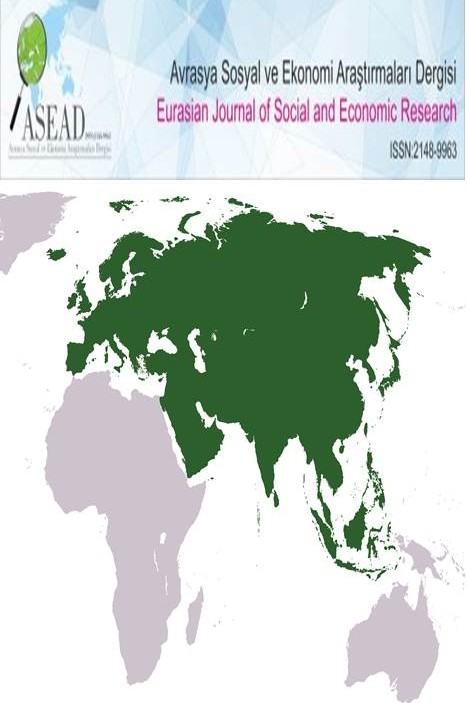TURİZM DESTİNASYONLARINDA FAALİYET GÖSTEREN ÜRETİM İŞLETMELERİNDE ÇALIŞANLARIN TERS LOJİSTİK ALGISI
This study investigates the perceptions of reverse logistics among production companies’ employees in tourism destinations. Reverse logistics manages product returns and their impact on sustainability, which is crucial for businesses in such environments. Quantitative analysis was conducted using survey methodology to collect data from 450 employees in Antalya in August 2019, a renowned tourism destination. Parametric tests were conducted as the scores showed a normal distribution. Various tests such as factor analysis, independent samples t-test, and one-way ANOVA were used to examine the research objectives. The study examines five fundamental aspects of reverse logistics perception: recycling, remanufacturing, product improvement, alternative recycling methods, and refurbishment. The findings indicate a generally low perception of reverse logistics among the participants. There is no statistically significant difference in logistics perception based on gender, age, or income, unlike employees. However, unlike employees, it has been determined that logistics perception differs significantly according to marital status and educational background. It has been determined that unmarried employees have a more favorable attitude toward recycling than married employees. Furthermore, it has been observed that the refurbishing perceptions of primary school graduates' employees are lower. Consequently, unlike their counterparts, this study exposes the logistic perceptions of employees in manufacturing companies in tourism destinations. Results emphasize the significance of promoting sustainable practices in the tourism sector, highlighting the need for a deeper understanding and increased awareness of reverse logistics.
Anahtar Kelimeler:
Tersine Lojistik, Turizm, İşgören
REVERSE LOGISTIC PERCEPTION OF EMPLOYEES IN PRODUCTION ENTERPRISES OPERATING IN TOURISM DESTINATIONS
___
- Acar, A. Z., & Kara, K. (2014). Tersine Lojistik. İçinde A. Z. Acar ve A. M. Köseoğlu (Editörler), Lojistik Yaklaşımıyla Tedarik Zinciri Yönetimi. Nobel Akademik Yayıncılık.
- Agrawal, S., Singh, R. K., & Murtaza, Q. (2015). A literature review and perspectives in reverse logistics. Resources, Conservation and Recycling, 97, 76-92.
- Autry, C. W., Daugherty, P. J., & Glenn Richey, R. (2001). The challenge of reverse logistics in catalog retailing. International Journal of Physical Distribution & Logistics Management, 31(1), 26-37.
- Büyükkeklik, A., & Ergülen, A. (2016). Tersine Lojistik Çalışmalarının Araştırma Yöntemlerine Göre Sınıflandırılması. Pamukkale Üniversitesi, Sosyal Bilimler Enstitüsü Dergisi, 25(1), 47-73.
- Carter, C. R., & Ellram, L. M. (1998). Reverse logistics: a review of the literature and framework for future investigation. Journal of Business Logistics, 19(1), 85-102.
- Castell A., Clift R., France C. (2004). Extended producer responsibility policy in the European Union—a horse or a camel? Journal of Industrial Ecology, 8(1–2), 4-7.
- Erdal, M., Görçün, Ö. F., Görçün, Ö., & Saygılı, M. S. (2010). Entegre Lojistik Yönetimi. Beta Yayınları.
- Eyüboğlu, G., & Bastı, M. (2017). Tersine lojistikte karşılaşılan sorunlar ve çözüm önerileri-Türk gıda sektörü örneği.
- Hall, D. J., Huscroft, J. R., Hazen, B. T., & Hanna, J. B. (2013). Reverse logistics goals, metrics, and challenges: perspectives from industry. International Journal of Physical Distribution & Logistics Management.
- Howell, D. C. (2012). Statistical methods for psychology. Cengage Learning. İlgün, A. (2010). Katı Atık Yönetimi Ve Ters Lojistik. Namık Kemal Üniversitesi Fen Bilimleri Enstitüsü Yüksek Lisans Tezi.
- Kalaycı, Ş. (2009). SPSS uygulamalı çok değişkenli istatistik teknikleri. Asil Yayınevi.
- Kayar, Y. (2015). Ters Lojistik Sürecinde Karşılaşılan Sorunlar Ve Çözümlere İlişkin Nitel Bir Araştırma. Namık Kemal Üniversitesi Sosyal Bilimler Enstitüsü İşletme Anabilim Dalı Yüksek Lisans Tezi.
- Kroon, L., & Vrijens, G. (1995). Returnable containers: an example of reverse logistics. International Journal of Physical Distribution & Logistics Management.
- Montgomery, D. C. (2017). Design and analysis of experiments. John Wiley & Sons.
- Mutuku, A. K., & Moronge, M. (2020). Influence of Reverse Logistics on Performance of Food and Beverage Manufacturing Firms in Kenya. International Journal of Supply Chain and Logistics, 4(2), 129-151.
- Ngadiman, N. I. B., Moeinaddini, M., Ghazali, J. B., & Roslan, N. F. B. (2016). Reverse logistics in food industries: A case study in Malaysia. International Journal of Supply Chain Management, 5(3), 91-95.
- Pokharel, S., & Mutha, A. (2009). Perspectives in reverse logistics: a review. Resources, Conservation and Recycling, 53(4), 175-182.
- Rogers, D. S., Lambert, D. M., & Knemeyer, A. M. (2004). The product development and commercialization process. The International Journal of Logistics Management, 15(1), 43-56.
- Sayın, B. (2017). Katı Atıklarda Tersine Lojistik Üzerine Toplumsal Algı: Gaziantep’te Bir Uygulama Yüksek Lisans Tezi. Hasan Kalyoncu Üniversitesi Sosyal Bilimler Enstitüsü Uluslararası Ticaret Ve Lojistik Anabilim Dalı.
- Subramanian, N., Gunasekaran, A., Abdulrahman, M., & Liu, C. (2014). Factors for implementing end-of-life product reverse logistics in the Chinese manufacturing sector. International Journal of Sustainable Development & World Ecology, 21(3), 235-245.
- Tukey, J. W. (1949). Comparing individual means in the analysis of variance. Biometrics, 5(2), 99-114.
- Yalçı, E. B., Altuğ, N., & Akın, Y. K. (2017). Tüketicilerin Sosyal Sorumluluk Bilinci Doğrultusunda Tersine Lojistiğe Bakış Açıları. Akademik Bakış Uluslararası Hakemli Sosyal Bilimler Dergisi, (60), 383-395.
- Yayın Aralığı: Yılda 4 Sayı
- Başlangıç: 2014
- Yayıncı: İrfan TÜRKOĞLU
Sayıdaki Diğer Makaleler
Bilal KARTAL, Özgür TUTAL, Büşra KANSİZOGLU
ÇAĞDAŞ SANATTA NESNEL GERÇEKLİĞİN ÖTESİNİ SUNMA ARACI OLARAK “AŞKINLIK” KAVRAMI
İÇ KONTROL SÜRECİNDE BİREY-ÖRGÜT UYUMUNUN İŞ TATMİNİ ÜZERİNE ETKİSİNİN ARAŞTIRILMASI
Zabit KEKEÇ, Hikmet YAŞAR, Osman MALKOÇOĞLU, Mete SUNGUR
GİYSİNİN HEYKELE DÖNÜŞÜMÜ: ÖRNEKLERİN TEKNİK AÇIDAN İNCELENMESİ
UMUDUN PSİKOLOJİK İYİ OLUŞA ETKİSİNDE İYİMSERLİĞİN ARACILIK ROLÜ
Betül OKUDUR SABUNCU, Dilek KOCABAŞ, Ahmet Yasin ŞENYURT
Mustafa Caner TİMUR, Özlem DURGUN
PAZARLAMA ALANYAZININDA PANİK SATIN ALMA DAVRANIŞI
